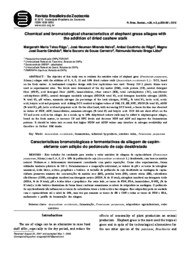Chemical and bromatological characteristics of elephant grass silages with the addition of dried cashew stalk.
Chemical and bromatological characteristics of elephant grass silages with the addition of dried cashew stalk.
Author(s): RÊGO, M. M. T.; NEIVA, J. N. M.; RÊGO, A. C.; CÂNDIDO, M. J. D.; CARNEIRO, M. S. de S.; LOBO, R. N. B.
Summary: The objective of this study was to evaluate the nutritive value of elephant grass (Pennisetum purpureum, Schum.) silages with the addition of 0, 4, 8, 12 and 16% dried cashew stalk (Anacardium occidentale L.) - DCS, based on the fresh matter. A randomized complete design with four replications was used. Twenty 210 L plastic drums were used as experimental silos. The levels were determined of the dry matter (DM), crude protein (CP), neutral detergent fiber (NDF), acid detergent fiber (ADF), hemicellulose, ether extract (EE), total carbohydrates (TC), non-fibrous carbohydrates (NFC), neutral detergent insoluble nitrogen (NDIN,% total N), acid detergent insoluble nitrogen (ADIN, % total N), pH values, ammonia nitrogen (in percentage of the total nitrogen, N-NH3, % total N), lactic acid, acetic acid, butyric acid and propionic acid. Adding DCS resulted in higher values of DM, CP, EE, NFC, NDIN (% total N), ADIN (% total N), pH, lactic acid and propionic acid. On the other hand, with increasing DCS levels, a linear decline was observed in values of NDF, ADF, hemicellulose, ammonia nitrogen (% total N) and butyric acid. DCS did not show effect on the TC and acetic acid in the silages. As a result, up to 16% dehydrated cashew stalk may be added to elephant-grass silages, based on the fresh matter, to increase CP and NFC levels and decrease NDF and ADF and improve the fermentation patterns. It should be taken into account that higher NDIN and ADIN values may interfere in nitrogen availability and therefore in further DM intake. [Características bromatológicas e fermentativas da silagem de capim-elefante com adição do pedúnculo de caju desidratado]. Resumo: Este trabalho foi conduzido para avaliar o valor nutritivo de silagens de capim-elefante (Pennisetum purpureum, Schum.) com 0, 4, 8, 12 e 16% de pedúnculo de caju (Anacardium occidentale L.) desidratado, com base na matéria natural. Utilizou-se o delineamento inteiramente casualizado com quatro repetições. Como silos experimentais, foram utilizados tambores plásticos de 210 L. Determinaram-se a composição nutricional, os valores de pH e os teores de nitrogênio amoniacal, ácido lático, acético, propiônico e butírico. A inclusão de pedúnculo de caju desidratado na ensilagem de capim-elefante promoveu aumento das concentrações de matéria seca (MS), proteína bruta (PB), extrato etéreo (EE), carboidratos não-fibrosos (CNF), nitrogênio insolúvel em detergente neutro (NIDN, % do N total), nitrogênio insolúvel em detergente ácido (NIDA, % do N total), pH e ácidos lático e propiônico. Por outro lado, os teores de FDN, FDA, hemicelulose, N-NH3 (% do N total) e ácido butírico diminuíram de forma linear conforme aumentaram os níveis do subproduto na ensilagem. O pedúnculo de caju desidratado não influenciou os teores de carboidratos totais e ácido acético das silagens. Esse subproduto pode ser ensilado com o capim-elefante até o nível de 16%, uma vez que aumenta os teores de PB e CNF e reduz os teores de FDN e FDA, melhorando o padrão de fermentação das silagens.
Publication year: 2010
Types of publication: Journal article
Unit: Embrapa Goats & Sheep
Observation
Some of Embrapa's publications are published as ePub files. To read them, use or download one of the following free software options to your computer or mobile device. Android: Google Play Books; IOS: iBooks; Windows and Linux: Calibre.
Access other publications
Access the Agricultural Research Database (BDPA) to consult Embrapa's full library collection and records.
Visit Embrapa Bookstore to purchase books and other publications sold by Embrapa.

